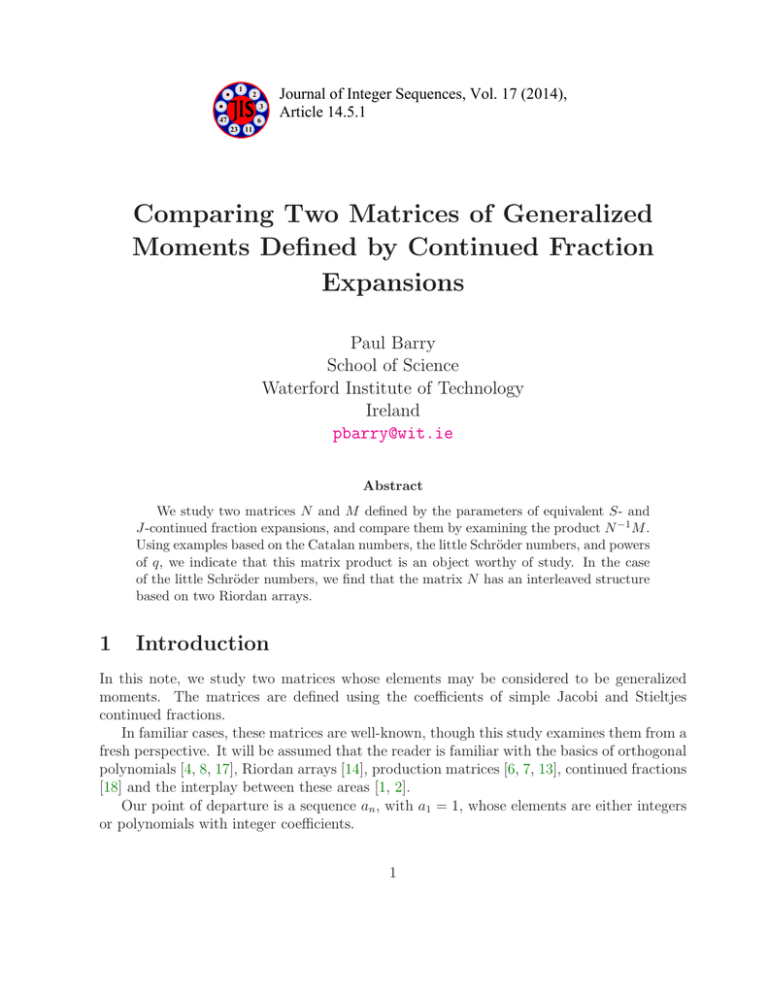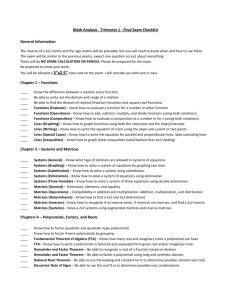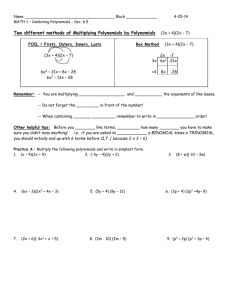Comparing Two Matrices of Generalized Moments Defined by Continued Fraction Expansions Paul Barry
advertisement

1 2 3 47 6 Journal of Integer Sequences, Vol. 17 (2014), Article 14.5.1 23 11 Comparing Two Matrices of Generalized Moments Defined by Continued Fraction Expansions Paul Barry School of Science Waterford Institute of Technology Ireland pbarry@wit.ie Abstract We study two matrices N and M defined by the parameters of equivalent S- and J-continued fraction expansions, and compare them by examining the product N −1 M . Using examples based on the Catalan numbers, the little Schröder numbers, and powers of q, we indicate that this matrix product is an object worthy of study. In the case of the little Schröder numbers, we find that the matrix N has an interleaved structure based on two Riordan arrays. 1 Introduction In this note, we study two matrices whose elements may be considered to be generalized moments. The matrices are defined using the coefficients of simple Jacobi and Stieltjes continued fractions. In familiar cases, these matrices are well-known, though this study examines them from a fresh perspective. It will be assumed that the reader is familiar with the basics of orthogonal polynomials [4, 8, 17], Riordan arrays [14], production matrices [6, 7, 13], continued fractions [18] and the interplay between these areas [1, 2]. Our point of departure is a sequence an , with a1 = 1, whose elements are either integers or polynomials with integer coefficients. 1 We will use these numbers to define two lower-triangular matrices, which we then compare. In both cases, the elements of the first column will be the sequence µn generated by the continued fraction 1 . a1 x 1− a2 x 1− a3 x 1− 1 − ··· We require that this sequence be Catalan-like, in the sense that we require all the Hankel determinants |µi+j |0≤i,j≤n to be non-zero. An equivalence transformation ensures that the sequence µn is the same as that generated by 1 . a1 a2 x 2 1 − a1 x − a3 a4 x 2 1 − (a2 + a3 )x − 1 − (a4 + a5 )x − · · · This exhibits µn as the moment sequence of the family of orthogonal polynomials Pn (x) that satisfy Pn (x) = (x − (a2n−2 + a2n−1 ))Pn−1 (x) − a2n−3 a2n−2 Pn−2 (x), with P0 (x) = 1, P1 (x) = x − a1 . The first matrix M that we shall be interested in is the inverse of the matrix of coefficients of these polynomials. The theory of production matrices and orthogonal polynomials tells us that this production matrix is given by a1 1 0 0 0 0 ... a1 a2 a2 + a3 1 0 0 0 ... 0 a3 a4 a4 + a5 1 0 0 ... 0 0 a a a + a 1 0 . . . 5 6 6 7 . 0 0 0 a7 a8 a8 + a9 1 ... 0 0 0 0 a a a + a . . . 9 10 10 11 .. .. .. .. .. .. ... . . . . . . The form of this production matrix ensures that the matrix M generated by it will be lower-triangular with 1’s on the diagonal. We obtain a matrix which begins 1 α α(α + β) α((α + β)2 + βγ) 3 α((α + β) + βγ(2α + 2β + γ + δ) . . . 0 1 α+β+γ 2 (α + β) + βγ + γ(α + β + γ + δ) (α + β + γ + δ + ǫ)2 − α(γ + δ + ǫ) − β(δ + ǫ) − ǫ(γ − φ) . . . 2 0 0 1 α+β+γ+δ+ǫ ··· . . . 0 0 0 1 ··· . . . 0 0 0 0 1 . . . ... ... ... ... ... .. . , where we have written α = a1 , β = a2 , and so on. In order to define the second matrix N , which again will have µn in the first column, we also use a production matrix. To construct this production matrix, we have two alternative routes. The first one proceeds as follows; we take the inverse of the matrix 1 0 0 0 0 0 ... −a1 1 0 0 0 0 ... 0 −a2 1 0 0 0 . . . 0 0 −a 1 0 0 . . . 3 0 0 0 −a4 1 0 . . . 0 0 0 0 −a 1 . . . 5 .. .. .. .. .. .. . . . . . . . . . to obtain the matrix 1 0 0 0 0 a1 1 0 0 0 a1 a2 a2 1 0 0 a1 a2 a3 a2 a3 a3 1 0 a1 a2 a3 a4 a2 a3 a4 a3 a4 a4 1 a1 a2 a3 a4 a5 a2 a3 a4 a5 a3 a4 a5 a4 a5 a5 .. .. .. .. .. . . . . . 0 0 0 0 0 1 .. . ... ... ... ... ... ... ... . We now behead this matrix (we remove the first row) to obtain the matrix. a1 1 0 0 0 0 a a a 1 0 0 0 1 2 2 a1 a2 a3 a2 a3 a3 1 0 0 a1 a2 a3 a4 a2 a3 a4 a3 a4 a4 1 0 a1 a2 a3 a4 a5 a a a a a a a a a a 1 2 3 4 5 3 4 5 4 5 5 a1 a2 a3 a4 a5 a6 a2 a3 a4 a5 a6 a3 a4 a5 a6 a4 a5 a6 a5 a6 a6 .. .. .. .. .. .. . . . . . . following production ... ... ... ... . ... ... ... The form of this production matrix ensures that the matrix N that it generates will be lower-triangular with 1’s on the diagonal. The matrix N that we seek then begins 1 α α(α + β) α((α + β)2 + βγ) α((α + β)3 + βγ(2α + 2β + γ + δ) . . . 0 1 α+β (α + β)2 + βγ 3 (α + β) + βγ(2α + 2β + γ + δ . . . where we have used α = a1 , β = a2 , and so on. 3 0 0 1 α+β+γ (α + β)2 + γ(α + δ) + (β + γ)2 . . . 0 0 0 1 ··· . . . 0 0 0 0 1 . . . ... ... ... ... ... .. . , There is an alternative production matrix approach to the construction of N . Multiplying the (n, k)-th element of N by k Y aj j=1 produces a lower triangular matrix whose first production matrix takes the simple form of a1 a1 0 0 a2 a2 a2 0 a3 a3 a3 a3 a4 a4 a4 a4 a5 a5 a5 a5 a6 a6 a6 a6 .. .. .. .. . . . . column is the same as that of N , and whose 0 0 0 0 0 0 a4 0 a5 a5 a6 a6 .. .. . . ... ... ... ... ... ... ... . We can clearly reverse this process, starting with the sequence an , to produce N . In order to compare the two matrices M and N , it is natural to examine the product −1 N M. Example 1. The Catalan matrices. We let an = 1. Thus we are interested in the sequence generated by the continued fraction 1 1− . x 1− x 1− x 1 − ··· 2n 1 This is the sequence of Catalan numbers Cn = n+1 , A000108. In this instance, the n production matrix of N for both methods of generation is given by 1 1 0 0 0 0 ... 1 1 1 0 0 0 ... 1 1 1 1 0 0 ... 1 1 1 1 1 0 ... , 1 1 1 1 1 1 ... 1 1 1 1 1 1 ... .. .. .. .. .. .. . . . . . . . . . and N is the Riordan array N = (c(x), xc(x)) = (1 − x, x(1 − x))−1 4 A033184. The matrix M is given by the Riordan array −1 1 x 2 M = (c(x), xc(x) ) = , 1 + x (1 + x)2 A039599, and the associated orthogonal polynomials are the Chebyshev polynomials Un ( x2 ). The production matrix of (c(x), xc(x)2 ) is given by 1 1 0 0 0 0 ... 1 2 1 0 0 0 ... 0 1 2 1 0 0 ... 0 0 1 2 1 0 ... , 0 0 0 1 2 1 ... 0 0 0 0 1 2 ... .. .. .. .. .. .. . . . . . . . . . corresponding to the generating function 1 1−x− x2 1 − 2x − x2 1 − 2x − · · · of Cn . A straight-forward Riordan array calculation now shows that in this case, x −1 −1 2 N · M = (c(x), xc(x)) · (c(x), xc(x) ) = 1, , 1−x which is the shifted binomial matrix 1 0 0 0 0 0 .. . 0 1 1 1 1 1 .. . 0 0 1 2 3 4 .. . 0 0 0 1 3 6 .. . 0 0 0 0 1 4 .. . 0 0 0 0 0 1 .. . ... ... ... ... ... ... ... Example 2. The q-case. We take the example of an = q n (q − 1)0n + , q q 5 . so that a1 = 1, a2 = q, a3 = q 2 , and so on. Starting with the matrix 1 0 0 0 0 −1 1 0 0 0 0 −q 1 0 0 2 0 0 −q 1 0 3 0 0 0 −q 1 0 0 0 0 −q 4 .. .. .. .. .. . . . . . 0 0 0 0 0 1 .. . ... ... ... ... ... ... ... , we invert it and behead the resulting matrix to get the production matrix 1 1 0 0 0 0 ... q q 1 0 0 0 ... q3 q3 q2 1 0 0 . . . q6 q6 q5 q3 1 0 . . . , q 10 q 10 q 9 q 7 q 4 1 . . . q 15 q 15 q 14 q 12 q 9 q 5 . . . .. .. .. .. .. .. . . . . . . . . . which we use to generate the matrix N : 1 1 q+1 q 3 + q 2 + 2q + 1 q 6 + q 5 + 2q 4 + 3q 3 + 3q 2 + 3q + 1 . .. 0 1 q+1 q 3 + q 2 + 2q + 1 q 6 + q 5 + 2q 4 + 3q 3 + 3q 2 + 3q + 1 . .. 0 0 1 q2 + q + 1 q 5 + q 4 + 2q 3 + 2q 2 + 2q + 1 . .. 0 0 0 1 ··· . .. ... ... ... ... ... .. . In the left column we recognize the q-Catalan sequence µn with generating function 1 1− x . qx q2x 1− 1 − ··· Alternatively we may begin with the production matrix 1 1 0 0 0 0 ... q q q 0 0 0 ... q2 q2 q2 q2 0 0 . . . q3 q3 q3 q3 q3 0 . . . . q4 q4 q4 q4 q4 q4 . . . q5 q5 q5 q5 q5 q5 . . . .. .. .. .. .. .. . . . . . . . . . 1− 6 . Let Ñ be the matrix generated by this production matrix. Dividing column k of the M̃ by k Y ai = i=1 Y q i = q (2) , k i=1 we recover the matrix N . The generating function 1 1− x 1− is equivalent to qx q2x 1− 1 − ··· 1 1−x− . qx2 1 − (q + q 2 )x − q 5 x2 1− (q 3 + q 4 )x q 9 x2 − 1 − (q 5 + q 6 )x − · · · This leads to the production matrix 1 1 0 0 0 0 q q + q2 1 0 0 0 5 3 4 0 q q +q 1 0 0 9 5 6 0 0 q q + q 1 0 13 7 8 0 0 0 q q +q 1 17 9 0 0 0 0 q q + q 10 .. .. .. .. .. .. . . . . . . ... ... ... ... ... ... ... , which generates the matrix M , with first column equal to µn . The inverse of the matrix M is the coefficient array of the orthogonal polynomials defined by Pn (x) = (x − q 2n−3 (1 + q))Pn−1 (x) − q 4n−7 Pn−2 (x), where P0 (x) = 1 and P1 (x) = x − 1. For N −1 · M , we obtain the matrix that begins 7 0 0 0 0 0 1 .. . ... ... ... ... ... ... ... 0 0 0 0 0 1 .. . ... ... ... ... ... ... ... 1 0 0 0 0 0 1 0 0 0 2 0 q 1 0 0 0 q5 q3 + q4 1 0 9 7 8 9 4 5 6 0 q q +q +q q +q +q 1 14 12 13 14 15 9 10 11 12 13 5 6 0 q q +q +q +q q +q +q +q +q q + q + q7 + q8 .. .. .. .. .. . . . . . . Dividing each element Mn,k of M by q( n−k+2 2 )−1 , we obtain the matrix 1 0 0 0 0 0 1 0 0 0 0 1 1 0 0 0 1 q(1 + q) 1 0 2 2 2 2 0 1 q (1 + q + q ) q (1 + q + q ) 1 0 1 q 3 (1 + q + q 2 + q 3 ) q 4 (1 + q + 2q 2 + q 3 + q 4 ) q 3 (1 + q + q 2 + q 3 ) .. .. .. .. .. . . . . . which is the Hadamard product of the matrices 1 0 0 0 0 0 1 0 0 0 0 1 1 0 0 0 1 1+q 1 0 2 2 0 1 1+q+q 1+q+q 1 0 1 1 + q + q 2 + q 3 1 + q + 2q 2 + q 3 + q 4 1 + q + q 2 + q 3 .. .. .. .. .. . . . . . and 1 0 0 0 0 0 .. . 0 0 0 0 1 0 0 0 1 1 0 0 1 q 1 0 1 q2 q2 1 1 q3 q4 q3 .. .. .. .. . . . . 8 0 0 0 0 0 1 .. . ... ... ... ... ... ... ... , 0 0 0 0 0 1 .. . ... ... ... ... ... ... ... , , where the first matrix is the q-Riordan array k(n−k) n−1 n−k q [3], and the second matrix is a shifted version of the matrix q . The production matrix of N −1 · M begins 0 1 0 0 0 0 2 0 q 1 0 0 0 0 q 5 (q − 1) q 2 (q 2 + q − 1) 1 0 0 7 2 3 3 2 0 0 q (q − 1) q (q + q − 1) 1 0 10 3 4 4 3 0 0 0 q (q − 1) q (q + q − 1) 1 13 4 5 5 0 0 0 0 q (q − 1) q (q + q 4 − 1) .. .. .. .. .. .. . . . . . . ... ... ... ... ... ... ... , indicating that in this case, the inverse matrix (N −1 · M )−1 = M −1 · N is the coefficient array of a family of orthogonal polynomials whose parameters are given by the production matrix above. We look more closely at the case of q = 2. We find that 1 0 0 0 0 0 ... 1 1 0 0 0 0 ... 3 7 1 0 0 0 . . . 17 77 31 1 0 0 ... M = , 171 1471 1333 127 1 0 . . . 3113 51653 98487 21717 511 1 . . . .. . . .. .. .. .. .. . . . . . . . while Then N = 1 0 0 0 0 0 1 1 0 0 0 0 3 3 1 0 0 0 17 17 7 1 0 0 171 171 77 51 1 0 3113 3113 1471 325 31 1 .. .. .. .. .. .. . . . . . . −1 N ·M = ... ... ... ... ... ... ... 1 0 0 0 0 0 0 1 0 0 0 0 0 4 1 0 0 0 0 32 24 1 0 0 0 512 896 112 1 0 0 16384 61440 17920 480 1 .. .. .. .. .. .. . . . . . . 9 . ... ... ... ... ... ... ... . Looking at the reduced matrix 1 0 0 0 0 0 4 1 0 0 0 0 32 24 1 0 0 0 512 896 112 1 0 0 16384 61440 17920 480 1 0 1048576 8126464 5079040 317440 1984 1 .. .. .. .. .. .. . . . . . . ... ... ... ... ... ... ... we see that it is the moment array of the family of orthogonal polynomials whose parameters are given in the production matrix 4 1 0 0 0 0 ... 16 20 1 0 0 0 ... 0 384 88 1 0 0 . . . 0 0 7168 368 1 0 ... . 0 0 0 122880 1504 1 . . . 0 0 0 0 2031616 6080 . . . .. .. .. .. .. .. ... . . . . . . We deduce that the sequence 1, 4, 32, 512, 16384, . . . or 2n(n+3)/2 A036442 has a generating function given by 1 , 16x2 1 − 4x − 384x2 1 − 20x − 7168x2 1 − 88x − 1 − 368x − · · · or equivalently, 1 . 4x 1− 4x 1− 16x 1− 24x 1− 64x 1− 1 − ··· In this latter expression, the coefficients are given by the sequence b(n) = 2n+2 − 2(n+1)/2 (1 − (−1)n ). 10 The Hankel transform of 2n(n+3)/2 is then given by [10, 11, 12] hn = n−1 Y (b(2k + 1)b(2k + 2))n−k . k=0 A similar analysis can be carried out for q n(n+3)/2 . Example 3. The little Schröder numbers. In this example, we take a base sequence an given by 1, 1, 2, 1, 2, 1, 2, 1, 2, 1, 2, 1, 2, 1, 2, · · · . The sequence with generating function 1 1 = a1 x x 1− 1− a2 x 2x 1− 1− a3 x x 1− 1− 1 − ··· 1 − ··· is the sequence of little Schröder numbers A001003 1, 1, 3, 11, 45, 197, 903, . . . . These numbers are also generated by 1 1−x− . 2x2 1 − 3x − 2x2 1 − 3x − 2x2 1 − 3x − · · · We have 1 0 0 0 0 0 −1 1 0 0 0 0 0 −2 1 0 0 0 0 0 −1 1 0 0 0 0 0 −2 1 0 0 0 0 −1 1 .. .. .. .. .. .. . . . . . . ... ... ... ... ... ... ... −1 11 = 1 1 2 2 4 4 .. . 0 1 2 2 4 4 .. . 0 0 1 1 2 2 .. . 0 0 0 1 2 2 .. . 0 0 0 0 1 1 .. . 0 0 0 0 0 1 .. . ... ... ... ... ... ... ... , so that the matrix N in this case begins 1 0 0 0 0 1 1 0 0 0 3 3 1 0 0 11 11 4 1 0 45 45 17 6 1 197 197 76 31 7 .. .. .. .. .. . . . . . 0 0 0 0 0 1 .. . ... ... ... ... ... ... ... ... ... ... ... ... ... ... with production matrix For instance, we have 1 2 2 4 4 8 .. . 1 2 2 4 4 8 .. . 0 1 1 2 2 4 .. . 0 0 1 2 2 4 .. . 0 0 0 1 1 2 .. . 0 0 0 0 1 2 .. . . 17 = 1 · 11+1 · 4+2 · 1+2 · 0+ · · · , and 45 = 1 · 11+2 · 11+2 · 4+4 · 1+ · · · . The matrix M is given by 1 0 0 0 0 0 1 1 0 0 0 0 3 4 1 0 0 0 11 17 7 1 0 0 45 76 40 10 1 0 197 353 216 72 13 1 .. .. .. .. .. .. . . . . . . ... ... ... ... ... ... ... . This is the Riordan array A172094 √ √ −1 x 1 1 + x − 1 − 6x + x2 1 − 3x − 1 − 4x + x2 , , , = 4x 4x 1 + x 1 + 3x + 2x2 12 with production matrix 1 2 0 0 0 0 .. . 1 3 2 0 0 0 .. . 0 1 3 2 0 0 .. . 0 0 1 3 2 0 .. . 0 0 0 1 3 2 .. . 0 0 0 0 1 3 .. . ... ... ... ... ... ... ... . The matrix N is a “mixture” (in left to right interleaved fashion) [5] of this Riordan array and the related Riordan array √ −1 x 1 − 3x − 1 − 6x + x2 = 1, , 1, 4x 1 + 3x + 2x2 which has production matrix We have Nn,k 0 0 0 0 0 0 .. . 1 3 2 0 0 0 .. . 0 1 3 2 0 0 .. . 0 0 1 3 2 0 .. . 0 0 0 1 3 2 .. . 0 0 0 0 1 3 .. . ... ... ... ... ... ... ... . k/2 √ √ [xn ] 1+x− 1−6x+x2 1−3x− 1−6x+x2 , if k is even; 4x 4 = (k+1)/2 √ 2 [xn ]xk 1−3x− 1−6x+x , if k is odd. 4x2 We note that in like fashion, the matrix N −1 , which begins 1 0 0 0 0 0 ... −1 1 0 0 0 0 ... 0 −3 1 0 0 0 ... 0 1 −4 1 0 0 ... 0 0 7 −6 1 0 . . . 0 0 −1 11 −7 1 . . . .. .. .. .. .. .. . . . . . . . . . , is a “mixture” (in shifted alternate row fashion) of the two matrices 1 1 x x and . , , 1 + 3x + 2x2 1 + 3x + 2x2 1 + x 1 + 3x + 2x2 13 For instance, the array while the array begins ... ... ... ... ... ... ... 1 0 0 0 0 0 ... −1 1 0 0 0 0 ... 1 −4 1 0 0 0 ... −1 11 −7 1 0 0 ... 1 −26 30 −10 1 0 . . . −1 57 −102 58 −13 1 . . . .. .. .. .. .. .. . . . . . . . . . 1 0 0 0 0 0 −3 1 0 0 0 0 7 −6 1 0 0 0 −15 23 −9 1 0 0 31 −72 48 −12 1 0 −63 201 −198 82 −15 1 .. .. .. .. .. .. . . . . . . x 1 , 1+x 1+3x+2x2 We have 1 x , 1+3x+2x2 1+3x+2x2 , begins N −1 · M = 1 0 0 0 0 0 .. . We find that the production matrix of the 0 1 0 0 −1 1 0 0 −2 0 0 0 0 0 0 0 0 0 .. .. .. . . . 0 0 0 0 1 0 0 0 1 1 0 0 2 3 1 0 2 5 4 1 4 12 13 6 .. .. .. .. . . . . 0 0 0 0 0 1 .. . ... ... ... ... ... ... ... . . inverse of this matrix is given by 0 0 0 ... 0 0 0 ... 1 0 0 ... −1 1 0 ... . 0 −2 1 . . . 0 0 −1 . . . .. .. .. . . . . . . 14 This is the beheading of the inverse 1 0 0 1 0 1 0 2 0 2 0 4 .. .. . . of the matrix 0 0 1 2 2 4 .. . 0 0 0 1 1 2 .. . 0 0 0 0 1 2 .. . 0 0 0 0 0 1 .. . ... ... ... ... ... ... ... . The form of the production matrix of the inverse is reflected in the structure of N −1 · M as follows: the internal elements of each even row satisfy ti,j = 1 · t1−1,j−1 + 1 · ti−1,j , while for odd rows we have ti,j = 1 · ti−1,j−1 + 2 · ti−1,j . We remark that it is clear that the interleaved structure of N , based on two Riordan arrays, will be replicated in the case of any sequence an of the form 1, 1, r, 1, r, 1, r, 1, . . .. 2 Conclusion Using the parameters of equivalent Stieltjes and Jacobi continued fractions, we have defined two matrices N and M , and we have studied the product N −1 M in three specific cases. In each case, some noteworthy results have emerged. We conclude that the matrix N −1 M is worthy of further study. References [1] P. Barry and A. Hennessy, Meixner-type results for Riordan arrays and associated integer sequences, J. Integer Sequences, 13 (2010), Article 10.9.4. [2] P. Barry, Riordan arrays, orthogonal polynomials as moments, and Hankel transforms, J. Integer Sequences, 14 (2011), Article 11.2.2. [3] G.-S. Cheon, J.-H. Jung, and Y. Lim, A q-analogue of the Riordan group, Linear Algebra Appl., 439 (2013), 4119–4129. [4] T. S. Chihara, An Introduction to Orthogonal Polynomials, Gordon and Breach, New York, 1978. [5] D. E. Davenport, L. W Shapiro, and L. C. Woodson, The double Riordan group, Electron. J. Combin., 18 (2012), #P33. 15 [6] E. Deutsch, L. Ferrari, and S. Rinaldi, Production matrices, Adv. in Appl. Math., 34 (2005), 101–122. [7] E. Deutsch, L. Ferrari, and S. Rinaldi, Production matrices and Riordan arrays, Ann. Comb., 13 (2009), 65–85. [8] W. Gautschi, Orthogonal Polynomials: Computation and Approximation, Clarendon Press, Oxford, 2004. [9] I. Graham, D. E. Knuth, and O. Patashnik, Concrete Mathematics, Addison–Wesley, Reading, MA, 1994. [10] C. Krattenthaler, Advanced determinant calculus, Séminaire Lotharingien Combin. 42 (1999), Article B42q, available electronically at http://www.emis.de/journals/SLC/wpapers/s42kratt.html. [11] C. Krattenthaler, Advanced determinant calculus: A complement, Linear Algebra Appl., 411 (2005), 68–166. [12] J. W. Layman, The Hankel transform and some of its properties, J. Integer Sequences, 4 (2001), Article 01.1.5. [13] P. Peart and W.-J. Woan, Generating functions via Hankel and Stieltjes matrices, J. Integer Sequences, 3 (2000), Article 00.2.1. [14] L. W. Shapiro, S. Getu, W.-J. Woan, and L.C. Woodson, The Riordan Group, Discr. Appl. Math. 34 (1991), 229–239. [15] N. J. A. Sloane, The On-Line Encyclopedia of Integer Sequences. Published electronically at http://oeis.org, 2011. [16] N. J. A. Sloane, The On-Line Encyclopedia of Integer Sequences, Notices Amer. Math. Soc., 50 (2003), 912–915. [17] G. Szegö, Orthogonal Polynomials, 4th ed., Amer. Math. Soc., 1975. [18] H. S. Wall, Analytic Theory of Continued Fractions, AMS Chelsea Publishing, 1967. 2010 Mathematics Subject Classification: Primary 15B36; Secondary 11B83, 15A09, 30B70, 42C05. Keywords: Matrix, Stieltjes continued fraction, Jacobi continued fraction, orthogonal polynomials, production matrix, Riordan array, Hankel transform (Concerned with sequences A000108, A001003, A033184, A036442, A039599, and A172094.) 16 Received November 27 2013; revised version received March 18 2014. Published in Journal of Integer Sequences, March 22 2014. Return to Journal of Integer Sequences home page. 17








